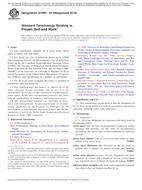1.1 This guide covers techniques that are appropriate for the construction and maintenance of skinned areas on baseball and softball fields. This guide provides guidance for the selection of materials, such as soil, sand, gravel, crushed stone, crushed brick, calcined clay, calcined diatomaceous earth, vitrified clay, etc., for use in constructing or reconditioning skinned areas and for the selection of management practices that will maintain a safe and playable skinned surface. Although this guide is specific to baseball/softball, it has application to other sports where ball bounce, ball roll, or player footing, or a combination thereof, are of importance.
1.2 Decisions in selecting construction and maintenance techniques are influenced by existing soil types, climatic factors, level of play, intensity of use, equipment available, budget, and training and ability of management personnel.
1.3 The values stated in SI units are to be regarded as the standard. The values in parentheses are for information only.
1.4 This standard may involve hazardous materials, operations, and equipment. This standard does not purport to address all of the safety concerns, if any, associated with its use. It is the responsibility of the user of this standard to establish appropriate safety and health practices and determine the applicability of regulatory requirements prior to use.
1.5 This guide offers an organized collection of information or a series of options and does not recommend a specific course of action. This document cannot replace education or experience and should be used in conjunction with professional judgment. Not all aspects of this guide may be applicable in all circumstances. The ASTM standard is not intended to represent or replace the standard of care by which the adequacy of a given professional service must be judged, nor should this document be applied without consideration of a project's many unique aspects. The word “Standard“ in the title of this document means only that the document has been approved through the ASTM consensus process.
Product Details
- Published:
- 11/01/2008
- Number of Pages:
- 8
- File Size:
- 1 file , 160 KB
- Redline File Size:
- 2 files , 300 KB


